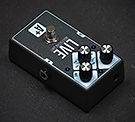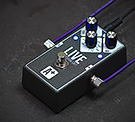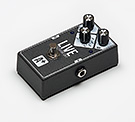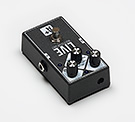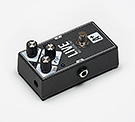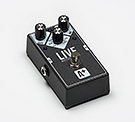-
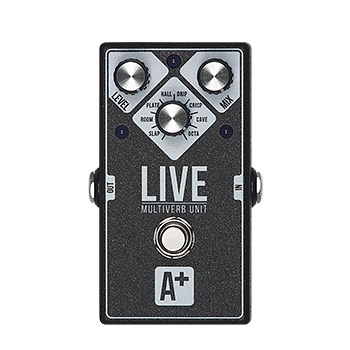
-
This product is discontinued.
Device name: LIVE
Effect type: Reverb
Instruments: Guitar, bass or any other signal source
Brief description: LIVE is a universal reverb pedal for rehearsals, live gigs and studio recordings.
The pedal’s diverse sound is constituted by 8 reverb algorithms (patches) that add depth and color to the guitar signal via different reverberation types, such as room, long hall, plate, spring and organ hall. The available algorithms provide reverb types that fit any style of music and are specifically programmed to let you achieve a great sound by simply choosing an algorithm and adjusting the mix.
LIVE can be used as a standalone device for acoustic sounds; add a distortion pedal to it, and you’ll get a minimal but sufficient pedalboard for any style of music, from jazz and Soviet pop to really heavy genres.
Together with a distortion pedal, LIVE will provide a bright, clean and dynamic sound with a 100% analog dry signal path in a compact and lightweight casing (just 350 grams).
Controls:- LEVEL — allows to boost the output signal to compensate for volume drop in the mix;
- MIX — controls the mix of the dry and processed signals;
- PROGRAM — selects one of the 8 available reverb algorithms (patches).
Patches (reverb algorithms):- SLAP — Slapback, a short tape-style delay, which was a popular way to add depth to the sound in the 50s. This effect can often be heard in rock-n-roll and rockabilly. It’s the shortest available delay (about 100 ms). This algorithm doesn’t simply provide a cold reflection; instead, it imitates double-tracking the signal to a second tape deck with a floating tape speed and delay. The minimal amount of reverb and feedback in the effect provides greater depth than a standard delay. Also, this algorithm allows slapback to be louder than the initial signal, which can be useful in the aforementioned styles.
- ROOM — The most transparent reverb effect, imitating a sound space with good live acoustic properties. This effect can fit any style of music. Reverb length and room size are programmed so that lower MIX settings just add a bit of depth to the signal but don’t sound like an audible reverb; at the same time, higher MIX settings can drown the signal in reverb.
- PLATE — This algorithm imitates mechanical reverberation from metal plates. This reverb type has a typical “metallic” sound and a broad frequency bandwidth. In LIVE, plate reverb has medium length and a prominent high frequency response, which makes it great for guitar and bass.
- HALL — The classic reverb effect that imitates a large hall with numerous reflective surfaces. Compared to ROOM reverb, HALL has higher diffusion and greater length. It has a massive low frequency response and is well-suited for music that requires prominent reverberation, such as ballads and solo pieces.
- DRIP — Spring reverb imitation. This reverb type is characterized by its decay curve and non-uniform time response of different frequencies. Spring reverberators often produce artifacts that sound like falling water drops. This reverb also has a “metallic” sound.
- CRISP — Modulated reverb that can really sing. Light modulation of the wet signal produces “floating” sounds that will grab the audience’s attention. This reverb is well-suited for solo pieces.
- CAVE — This algorithm imitates a large space with numerous obstacles at different distances, creating a deep diffusion field and thick reverb tails that sound like echoes in a cave.
- OCTA — An octave reverb for movie-style pads. This is an octave-down shimmer reverb algorithm, popular with the Astronaut pedal owners. In LIVE, it is slightly shorter and has a different mix of the direct and octave-down signal in the reverb tails. This algorithm is perfect for string emulations, ambient pads and diffusion-based sound effects.
Additional info:- The LIVE project was started in 2014 as an improved version of our Live! reverb that was released in 2011 and was based on Alesis AL3201 chips. Before the project was finished, we got completely occupied by its “spin-off”, Astronaut. In 2016, we got back to the main project, LIVE.
- In order to improve LIVE’s sound quality, its algorithms were reprogrammed three times. LIVE is our milestone as the fifth reverb pedal we’ve released. You can find the links to the previous four below.
- LIVE and Astronaut have a “yin-yang” relationship: either one has something from the other. Together, these two pedals can satisfy almost all reverb needs.
- When designing the pedal’s layout, we felt there were too many controls. Thus, we decided to program the best sounds as patches and strip the controls down to a minimum: one patch selection knob with mix and volume knobs for basic control. Being on stage is usually stressful, so one rarely gets to adjust lots of controls every song.
- LIVE has active bypass; otherwise, the click of the switch would get into the reverb tails and get multiplied. The pedal’s buffer doesn’t affect the signal in any way, as proved by the Astronaut.
- The dry signal doesn’t undergo any digital processing. The mix is analog. The MIX knob is a crossfade between the dry and the processed signal.
- At its max setting, the MIX knob makes the pedal go fully wet (the so-called “Kill Dry” mode). This allows using the device in a parallel loop.
- LIVE’s current draw may get up to 70mA, so a battery would last for no more than 1-2 hours and can only be viewed as an emergency power supply. It is strongly advised to use a power supply unit.
Dimension — 111 х 60 х 50 mm (4.37 x 2.36 x 1.97”)
Power supply — 9V, regulated.
Current draw — 70mA.
See also: A+ Astronaut reverb description


